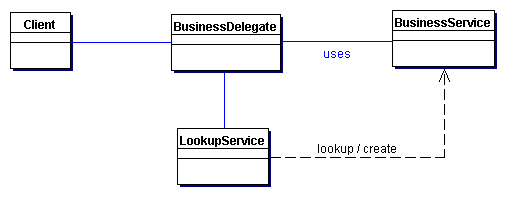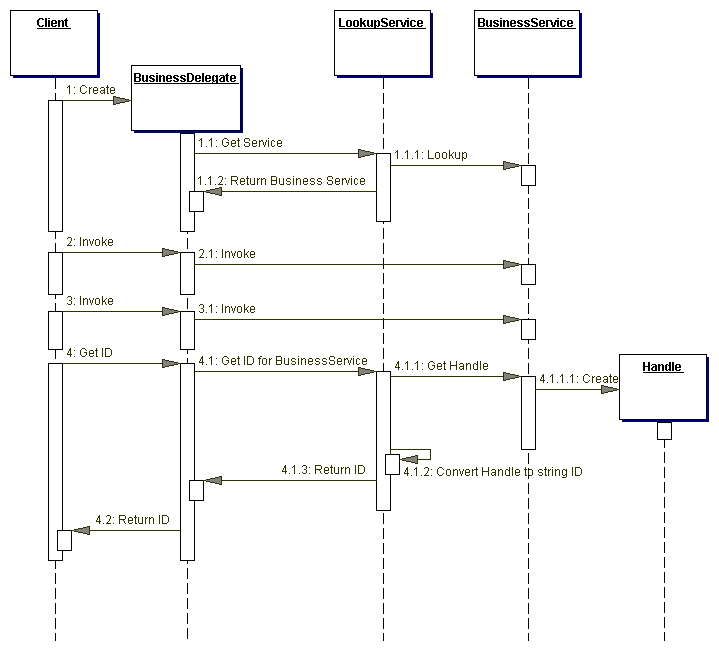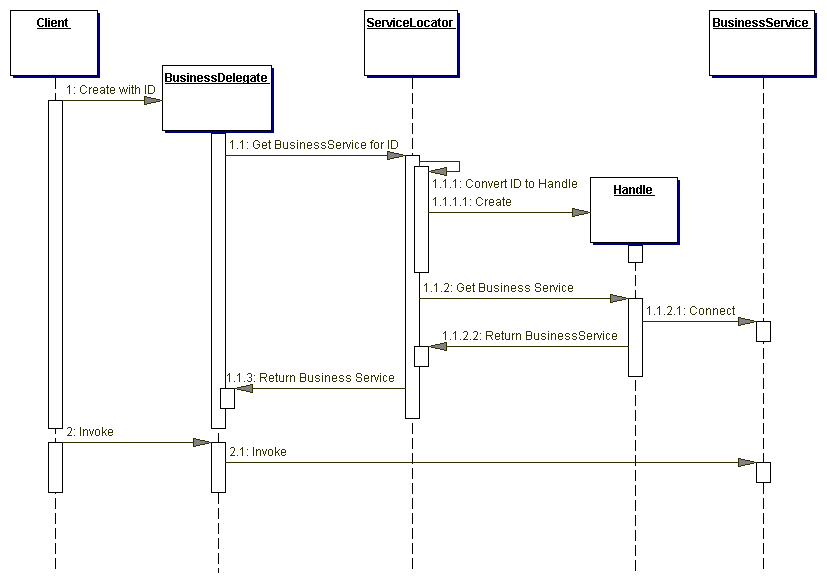Context
A multitiered, distributed system requires remote method invocations
to send and receive data across tiers. Clients are exposed to the complexity
of dealing with distributed components.
Problem
Presentation-tier components interact directly with business services.
This direct interaction exposes the underlying implementation details
of the business service application program interface (API) to the presentation
tier. As a result, the presentation-tier components are vulnerable to
changes in the implementation of the business services: When the implementation
of the business services change, the exposed implementation code in the
presentation tier must change too.
Additionally, there may be a detrimental impact on network performance
because presentation-tier components that use the business service API
make too many invocations over the network. This happens when presentation-tier
components use the underlying API directly, with no client-side caching
mechanism or aggregating service.
Lastly, exposing the service APIs directly to the client forces the client
to deal with the networking issues associated with the distributed nature
of EJB technology.
Forces
Solution
Use a Business Delegate to reduce coupling between presentation-tier
clients and business services. The Business Delegate hides the underlying
implementation details of the business service, such as lookup and access
details of the EJB architecture.
The Business Delegate acts as a client-side business abstraction; it
provides an abstraction for, and thus hides, the implementation of the
business services. Using a Business Delegate reduces the coupling between
presentation-tier clients and the system's business services. Depending
on the implementation strategy, the Business Delegate may shield clients
from possible volatility in the implementation of the business service
API. Potentially, this reduces the number of changes that must be made
to the presentation-tier client code when the business service API or
its underlying implementation changes.
However, interface methods in the Business Delegate may still require
modification if the underlying business service API changes. Admittedly,
though, it is more likely that changes will be made to the business service
rather than to the Business Delegate.
Often, developers are skeptical when a design goal such as abstracting
the business layer causes additional upfront work in return for future
gains. However, using this pattern or its strategies results in only a
small amount of additional upfront work and provides considerable benefits.
The main benefit is hiding the details of the underlying service. For
example, the client can become transparent to naming and lookup services.
The Business Delegate also handles the exceptions from the business services,
such as java.rmi.Remote exceptions, JMS exceptions and so on. The Business
Delegate may intercept such service level exceptions and generate application
level exceptions instead. Application level exceptions are easier to handle
by the clients, and may be user friendly. The Business Delegate may also
tranparently perform any retry or recovery operations necessary in the
event of a service failure without exposing the client to the problem
until it is determined that the problem is not resolvable. These gains
present a compelling reason to use the pattern.
Another benefit is that the delegate may cache results and references
to remote business services. Caching can significantly improve performance,
because it limits unnecessary and potentially costly round trips over
the network.
A Business Delegate uses a component called the Lookup Service. The Lookup
Service is responsible for hiding the underlying implementation details
of the business service lookup code. The Lookup Service may be written
as part of the Delegate, but we recommend that it be implemented as a
separate component, as outlined in the Service Locator pattern (See "Service
Locator" on page 368.)
When the Business Delegate is used with a Session Facade, typically there
is a one-to-one relationship between the two. This one-to-one relationship
exists because logic that might have been encapsulated in a Business Delegate
relating to its interaction with multiple business services (creating
a one-to-many relationship) will often be factored back into a Session
Facade.
Finally, it should be noted that this pattern could be used to reduce
coupling between other tiers, not simply the presentation and the business
tiers.
Structure
Figure 8.1 shows the class diagram representing the Business Delegate
pattern. The client requests the BusinessDelegate to provide access to
the underlying business service. The BusinessDelegate uses a LookupService
to locate the required BusinessService component.

Figure 8.1 BusinessDelegate class diagram
Participants and Responsibilities
Figure 8.2 and Figure 8.3 show sequence diagrams that illustrate typical
interactions for the Business Delegate pattern.

Figure 8.2 BusinessDelegate sequence diagram
The BusinessDelegate uses a LookupService for locating the business service.
The business service is used to invoke the business methods on behalf
of the client. The Get ID method shows that the BusinessDelegate can obtain
a String version of the handle (such as EJBHandle object) for the business
service and return it to the client as a String. The client can use the
String version of the handle at a later time to reconnect to the business
service it was using when it obtained the handle. This technique will
avoid new lookups, since the handle is capable of reconnecting to its
business service instance. It should be noted that handle objects are
implemented by the container provider and may not be portable across containers
from different vendors.
The sequence diagram in Figure 8.3 shows obtaining a BusinessService
(such as a session or an entity bean) using its handle.

Figure 8.3 BusinessDelegate with ID sequence diagram
BusinessDelegate
The BusinessDelegate's role is to provide control and protection for
the business service. The BusinessDelegate can expose two types of constructors
to clients. One type of request instantiates the BusinessDelegate without
an ID, while the other instantiates it with an ID, where ID is a String
version of the reference to a remote object, such as EJBHome or EJBObject.
When initialized without an ID, the BusinessDelegate requests the service
from the Lookup Service, typically implemented as a Service Locator (see
"Service Locator" on page 368), which returns the Service Factory,
such as EJBHome. The BusinessDelegate requests that the Service Factory
locate, create, or remove a BusinessService, such as an enterprise bean.
When initialized with an ID string, the BusinessDelegate uses the ID
string to reconnect to the BusinessService. Thus, the BusinessDelegate
shields the client from the underlying implementation details of BusinessService
naming and lookup. Furthermore, the presentation-tier client never directly
makes a remote invocation on a BusinessSession; instead, the client uses
the BusinessDelegate.
LookupService
The BusinessDelegate uses the LookupService to locate the BusinessService.
The LookupService encapsulates the implementation details of BusinessService
lookup.
BusinessService
The BusinessService is a business-tier component, such as an enterprise
bean or a JMS component, that provides the required service to the client.
Strategies
Delegate Proxy Strategy
The Business Delegate exposes an interface that provides clients access
to the underlying methods of the business service API. In this strategy,
a Business Delegate provides proxy function to pass the client methods
to the session bean it is encapsulating. The Business Delegate may additionally
cache any necessary data, including the remote references to the session
bean's home or remote objects to improve performance by reducing the number
of lookups. The Business Delegate may also convert such references to
String versions (IDs) and vice versa, using the services of a Service
Locator.
The example implementation for this strategy is discussed in the "Sample
Code" section of this pattern.
Delegate Adapter Strategy
The Business Delegate proves to be a nice fit in a B2B environment when
communicating with J2EE services. Disparate systems may use an XML as
the integration language. Integrating one system to another typically
requires an Adapter [GoF] to meld the two disparate systems. Figure 8.4
gives an example.

Figure 8.4 Using the Business Delegate pattern with an Adapter strategy
Consequences
-
Reduces Coupling, Improves Manageability
The Business Delegate reduces coupling between the presentation tier
and the business tier by hiding all business-tier implementation details.
It is easier to manage changes because they are centralized in one
place, the Business Delegate. - Translates Business Service Exceptions
The Business Delegate is responsible for translating any network or
infrastructure-related exceptions into business exceptions, shielding
clients from knowledge of the underlying implementation specifics.
- Implements Failure Recovery and Thread Synchronization
The Business Delegate on encountering a business service failure, may
implement automatic revovery features without exposing the problem to
the client. If the recovery succeeds, the client need not know about
the failure. If the recovery attempt does not succeed, then the Business
Delegate needs to inform the client of the failure. Additionally, the
business delegate methods may be synchronized, if necessary.
- Exposes Simpler, Uniform Interface to Business Tier
The Business Delegate, to better serve its clients, may provide a variant
of the interface provided by the underlying enterprise beans.
- Impacts Performance
The Business Delegate may provide caching services (and better performance)
to the presentation tier for common service requests.
- Introduces Additional Layer
The Business Delegate may be seen as adding an unnecessary layer between
the client and the service, thus introducing added complexity and decreasing
flexibility. Some developers may feel that it is an extra effort to
develop Business Delegates with implementations that use the Delegate
Proxy strategy. At the same time, the benefits of the pattern typically
outweigh such drawbacks.
- Hides Remoteness
While location transparency is one of the benefits of this pattern,
a different problem may arise due to the developer treating a remote
service as if it was a local one. This may happen if the client developer
does not understand that the Business Delegate is a client side proxy
to a remote service. Typically, a method invocations on the Business
Delegate results in a remote method invocation under the wraps. Ignoring
this, the developer may tend to make numerous method invocations to
perform a single task, thus increasing the network traffic.
Sample Code
Implementing the Business Delegate Pattern
Consider a Professional Services Application (PSA), where a Web-tier
client needs to access a session bean that implements the Session Facade
pattern. The Business Delegate pattern can be applied to design a Delegate
class ResourceDelegate, which encapsulates the complexity of dealing with
the session bean ResourceSession. The ResourceDelegate implementation
for this example is shown in Example 8.1, and the corresponding remote
interface for the Session Facade bean ResourceSession is shown in Example
8.2.
Example 8.1 Implementing Business Delegate Pattern - ResourceDelegate
// imports
...
public class ResourceDelegate {
// Remote reference for Session Facade
private ResourceSession session;
// Class for Session Facade's Home object
private static final Class homeClazz =
corepatterns.apps.psa.ejb.ResourceSessionHome.class;
// Default Constructor. Looks up home and connects
// to session by creating a new one
public ResourceDelegate() throws ResourceException {
try {
ResourceSessionHome home = (ResourceSessionHome)
ServiceLocator.getInstance().getHome(
"Resource", homeClazz);
session = home.create();
} catch(ServiceLocatorException ex) {
// Translate Service Locator exception into
// application exception
throw new ResourceException(...);
} catch(CreateException ex) {
// Translate the Session create exception into
// application exception
throw new ResourceException(...);
} catch(RemoteException ex) {
// Translate the Remote exception into
// application exception
throw new ResourceException(...);
}
}
// Constructor that accepts an ID (Handle id) and
// reconnects to the prior session bean instead
// of creating a new one
public BusinessDelegate(String id)
throws ResourceException {
super();
reconnect(id);
}
// Returns a String ID the client can use at a
// later time to reconnect to the session bean
public String getID() {
try {
return ServiceLocator.getId(session);
} catch (Exception e) {
// Throw an application exception
}
}
// method to reconnect using String ID
public void reconnect(String id)
throws ResourceException {
try {
session = (ResourceSession)
ServiceLocator.getService(id);
} catch (RemoteException ex) {
// Translate the Remote exception into
// application exception
throw new ResourceException(...);
}
}
// The following are the business methods
// proxied to the Session Facade. If any service
// exception is encountered, these methods convert
// them into application exceptions such as
// ResourceException, SkillSetException, and so
// forth.
public ResourceTO setCurrentResource(
String resourceId)
throws ResourceException {
try {
return session.setCurrentResource(resourceId);
} catch (RemoteException ex) {
// Translate the service exception into
// application exception
throw new ResourceException(...);
}
}
public ResourceTO getResourceDetails()
throws ResourceException {
try {
return session.getResourceDetails();
} catch(RemoteException ex) {
// Translate the service exception into
// application exception
throw new ResourceException(...);
}
}
public void setResourceDetails(ResourceTO vo)
throws ResourceException {
try {
session.setResourceDetails(vo);
} catch(RemoteException ex) {
throw new ResourceException(...);
}
}
public void addNewResource(ResourceTO vo)
throws ResourceException {
try {
session.addResource(vo);
} catch(RemoteException ex) {
throw new ResourceException(...);
}
}
// all other proxy method to session bean
...
}
Example 8.2 Remote Interface for ResourceSession
// imports
...
public interface ResourceSession extends EJBObject {
public ResourceTO setCurrentResource(
String resourceId) throws
RemoteException, ResourceException;
public ResourceTO getResourceDetails()
throws RemoteException, ResourceException;
public void setResourceDetails(ResourceTO resource)
throws RemoteException, ResourceException;
public void addResource(ResourceTO resource)
throws RemoteException, ResourceException;
public void removeResource()
throws RemoteException, ResourceException;
// methods for managing blockout time by the
// resource
public void addBlockoutTime(Collection blockoutTime)
throws RemoteException, BlockoutTimeException;
public void updateBlockoutTime(
Collection blockoutTime)
throws RemoteException, BlockoutTimeException;
public void removeBlockoutTime(
Collection blockoutTime)
throws RemoteException, BlockoutTimeException;
public void removeAllBlockoutTime()
throws RemoteException, BlockoutTimeException;
// methods for resource skillsets time by the
//resource
public void addSkillSets(Collection skillSet)
throws RemoteException, SkillSetException;
public void updateSkillSets(Collection skillSet)
throws RemoteException, SkillSetException;
public void removeSkillSet(Collection skillSet)
throws RemoteException, SkillSetException;
...
}
Related Patterns
|


